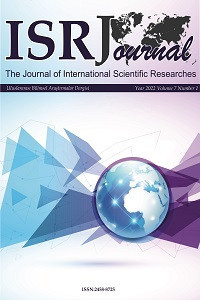Şehir Markalaşmasında Online İçeriğin Önemi: Gümüşhane Örneği
Şehir Markalaşması, sosyal medya, Şehir Pazarlama
The Importance of Online Context in City Branding: Gümüşhane Sample
City Branding, Social Media, city marketing,
___
- Anholt, S. (2011). Yerlerin Markalaşması Kimlik, İmaj Ve İtibar. İstanbul: Brandage Yayınları.
- Baloğlu S., Pekcan Y. A. (2006). “The website design and Internet site marketing practices of upscale and luxury hotels in Turkey”, Tourism Ma- nagement 27, s.171–176.
- Buhalis D., Leung D. ve Law R. (2011) “eTourism: Critical Information and Communication Technologies for Tourism Destinations”, Destination Marketing and Management Theories and Applications, Ed: Youcheng Wang & Abraham Pizam, CAB International, 205-224.
- Doorley J. ve Helio F. G. (2007). “Reputation Management : The Key to Successful Public Relations and Corporate Communication”, London: Routledge.
- Feng R, Morrison A. M., Ismail J. A., (2003), East Versus West: A comparison of online destination marketing in China and the USA, Journal of Vacation Marketing, Vol. 10 No. 1;pp43-56.
- Inversini, A., & Buhalis, D. (2009). Information convergence in the long tail: The case of tourism destination information. Information and Communication technologies in tourism 2009, 381-392.
- İlgüner M. and Asplund C., (2011), Marka Şehir, Markating Yayınları, İstanbul.
- Kim, W., Jeong, O-R., Lee, S-W. (2010). “On Social Web Sites”, Information Systems, journal homepage: www.elsevier.com/locate/infosys, 35, 215-236.
- Kim S., Kim D., Wise K. (2014) The effect of searching and surfing on recognition of destination images on Facebook pages, Computers in Human Behavior 30 813–823.
- Kotler P., Armstrong G. (2012), Principles of Marketing, Pearson Prentice Hall.
- Litvin, S. W., R. E. Goldsmith, ve B. Pan (2008) Electronic word-of-mouth in hospitality and tourism management.» Tourism Management , 2008: 29 458–468.
- Mandelli, A., ve L. Cantoni, (2010), Social Media İmpact on Corporate Reputation; Proposing a new methodological approach. Cuadernos De Informacıón: Nº 27 / 2010 - Ii (Julio - Diciem Bre ) / ISSN 0716-162x.
- Martinez N. M., Blanco M. C., (2009), Identity and Marketing of Cities, Üniversidad de Leon, Spain, Information Communication Technologies and City Marketing:Digital Opprtunities for Cities Around The World, Hernandez M.G. and Coronas T.T., 2009, Spain.
- Pan, B. & Fesenmaier, D.R. (2006). Online information search: Vacation planning process, Annals of Tourism Research, 33.
- Pike S. (2008) Destination Marketing An Integrated Marketing Communication Approach, Elsevier.
- Safko, L., (2012) The Social Media Bible - Tactics, Tools & Strategies For Business Success. New Jersey: John Wiley.
- Xiang, Z., & Gretzel, U. (2010). Role of social media in online travel information search. Tourism Management 31 , s. 179–188 ScienceDirect.
- Zenker, S., & Braun, E. (2010). Branding a city – a conceptual approach for place branding and place brand management. Proceedings of the 39th European Marketing Academy Conference 2010, Copenhagen, Denmark.
- Zhou L., Wang T. (2014) Social media: A new vehicle for city marketing in China Cities, Sayı 37, Nisan 2014, ss 27-32.
- ISSN: 2458-8725
- Yayın Aralığı: Yılda 3 Sayı
- Başlangıç: 2016
- Yayıncı: Salih YILDIZ
Kültürel Mirasın Ekonomik Değer ve Marka Şehir Pazar Performansına Etkisi
Kutalmış Emre CEYLAN, Abdullah ERAVCI
Semantik Web’in Marka İtibarına Etkisi Üzerine Bir Araştırma
Sosyal Medya Reklamlarında Fenomen Kullanımı ve Reklam İzleme Tercihi
Yer Markacılığı Bağlamında Engelsiz Marka Şehirlerinin Gümüşhane Örneğinde Analizi
Erol DÖNEK, Merve ÖZKAYNAK, Mine ULUSOY
Marka Olarak Spor Kulüplerinin Sosyal Medya Kullanımı: Türk Spor Kulüpleri Üzerine Bir Araştırma
Marka Değerinin Hesaplanmasında Farklı Bir Yaklaşım: Geliştirilmiş Hirose Yöntemi
Alper Veli ÇAM, Yusuf KALKAN, Şafak Sözmez SOYDAŞ, Seda SAĞLAMYÜREK TAŞDEMİR
Yer Markacılığı Bağlamında Çocuk Dostu Kent Kavramı ve Yer Markalaşmasına İlişkin Bir Çözümleme
Marka Değeri ve Firma Değeri İlişkisi: Finansal Tabanlı Bir Model
Alper Veli ÇAM, Yusuf KALKAN, Şafak Sönmez SOYDAŞ, Seda SAĞLAMYÜREK TAŞDEMİR
Şehir Markalaşmasında Tarihi Yapıların Rolü: Konya-Selçuklu Yapıları
